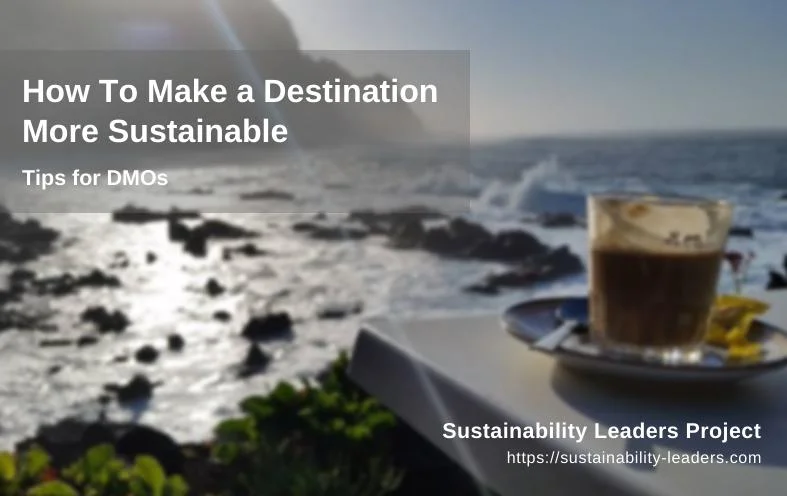Which actions can Destination Marketing & Management Organizations (DMOs) initiate right away to support the sustainable development of their destination?
This was our question to the destination sustainability panel which we convened together with The Place Brand Observer earlier this year.
Below the panel’s answers (in alphabetical order – highlighted respondents are available for consulting or as speakers).
Our key takeaways:
- First, consult with stakeholders to inform and sensitize them.
- Use existing tools, such as the Green Destinations Standard or the GSTC criteria for destinations, to find out where you stand and to guide your envisioning and planning.
- Monitor implementation of your sustainable destination strategy and equip it with sufficient funds to be fruitful. Share results and success stories with your stakeholders and with travellers.
- Don’t oversell. Consider destination sustainability to be a quality management exercise, rather than a marketing asset.
Albert Salman, Netherlands:
Interview
1) Create a stakeholder group with the task to consider ideas for sustainable tourism.
2) Download the Green Destinations Standard and give it for consideration to the stakeholder group.
3) Develop a vision for your destination for 2020-2025.
Amine Ahlafi, Morocco:
Interview
1) Ensure that the destination has a strategic framework and a clear roadmap for sustainable development across all links in the tourism product value chain: planning, accommodation, transportation, animation, training and capacity building.
2) Educate and sensitize all stakeholders on the interest and urgency to move towards sustainable and responsible actions.
3) Monitor the implementation of the actions, taking into account the impacts generated and the expectations of the clientele.
Anna Alaman, India:
Interview
Integrate initiatives for climate-neutral tours. Which means that travellers and tourism stakeholders need to take responsibility and share offset cost, including international flights of customers’ holiday trips.
Employ more women in non-conventional jobs in tourism, like guides or drivers.
Stop promoting visits to cruel animal attractions.
Gavin Bate, United Kingdom:
Interview
1) Get out of the office, away from the computer and books, and visit local people in the area and talk. Build trust by bringing in the opinions and views of ‘the little people’ and invite them to be part of the debate.
2) Act on the opinions of others, and build trust by making people believe they genuinely have a voice and it is being heard. This is the only way to create a following.
3) Educate people. Change happens with knowledge and people need to be trusted and informed. This means getting out of the office and spending time with people, building relationships and turning stories into actions.
As you can see, I believe that the attitude needs to be right first. Sustainable development doesn’t begin with academics or people in positions of power to legislate, it begins with the people.
Gianna Moscardo, Australia:
Interview
Get more diverse community representatives on tourism planning and development committees and boards – expand to people from welfare agencies and people who are advocates for a wide range of different sectors within the community, not just tourism business and government agencies.
Do some research to establish what is positive about residents’ current well-being – for instance, what do they value right now about their community that should be protected, what well-being needs do they have (what specific things they need right now – like better healthcare, or more public transport) and what their aspirations are for the future. Use these to guide decisions about what type of tourism to pursue.
So the whole planning and development process should be driven by community needs and goals, not business and market opportunities.
See tourism as a tool for the destination community, not the destination community as a resource for tourism. It is a simple but subtle distinction that makes a great deal of difference.
Jonathan Tourtellot, USA:
Interview
1) Convene a destination stewardship council or equivalent.
2) With active community participation in the council, adopt a mission statement and principles to steer by, signed/endorsed by as many stakeholders as possible.
3) Develop a destination management plan in keeping with those principles, preferably including steps to achieve certification where appropriate.
 Jonathon Day, USA:
Jonathon Day, USA:
Interview | Placemark Solutions | Speaker
This question assumes that it is the DMO that is central to the implementation of sustainable tourism and that assumption needs to be addressed critically. As DMOs add development responsibilities they are being exposed to sustainable development issues. But traditionally, the reality is that DMOs haven’t been responsible for activities that lead to sustainable tourism, including policy development, infrastructure development etc.
There are still many DMOs who would question what sustainability has to do with them (and if they see a possible role – are unsure what they could do about it anyway). So what can they do ?
- Walk the talk. Ensure their own operations are sustainable.
- Raise awareness and build coalitions of actors: While DMOs have little authority to implement ST – they can be important catalysts for change. They have a vested interest in the success of ST programs – the quality of the destination over time is dependent on this work. Raising awareness and using their influence with stakeholders is a key role for DMOs in destinations adopting sustainable tourism.
- Start collecting meaningful information – beyond growth for growth’s sake.
Visitor experience, stakeholder sentiment, adoption of sustainability practices – each of these measures is as important as economic impact.
Use more critical insights: Instead of being driven by growth for growth’s sake (we grew 5% this year – yeah) start looking at yield and other metrics.
Real success messages: “We reduced the number of visitors but increased the spend of each visitor.” Or: “We increased the money that stayed in the local community.”
 Kelly Bricker, USA:
Kelly Bricker, USA:
Interview | Speaker
1) Support sustainable destination development through the support of the Global Sustainable Tourism Council as a member.
2) Review the Global Sustainable Tourism Council’s Destination Criteria
3) Measure where your destination lands against this criteria.
Kevin Teng, Singapore:
Interview
Support tourism businesses to:
1) Offer great sustainable food options to guests and staff.
2) Re-think accessibility and circulation on site, and to the site.
3) Measure their plastic footprint, and then to develop a plan to reduce this.
Maja Pak, Slovenia:
Interview
1) Start raising awareness of the necessity of sustainable development within the region – plan ahead, consistently and with passion.
2) Establish your own green team: a group of local opinion leaders and experts that work with you and open doors to relevant stakeholders.
3) Be innovative: think about all the possibilities that you have as a destination management organization and that can help you develop your destination sustainably. Make sure that your concrete actions consider the local community, environment and visitors.
Masaru Takayama, Japan:
Interview
1) Make a sustainable tourism management plan that focused on the long term.
2) Start a campaign on local gastronomy, local accommodation, local employment, etc. to prioritize local consumption.
3) Promote walking and low emission transportation over flying and driving.
 Natalia Naranjo, Colombia:
Natalia Naranjo, Colombia:
Interview | Comunitur
1) Build a participative action plan addressing the main issues related to the maintenance and improvement of your cultural, natural and social resources (use the GSTC criteria as a reference).
2) Identify responsibilities of all stakeholders towards the implementation of the action plan.
3) Equip the action plan with a proper budge and follow up on implementation and success.
Peter Richards, Thailand:
Interview
The more people get involved, with more skills and knowledge, the more is possible.
1) Consult stakeholders to share facts / experience / perspectives on the current positive and negative impacts of tourism in the destination. Then identify a vision and suitable brand personality for the destination, to facilitate a more integrated development.
2) Organise campaign style events, to generate public awareness and support for a well managed, clean, green destination. Examples of such events are clean up days, sponsored run sor bike rides.
3) Organise stakeholder workshops to introduce the GSTC criteria for destinations, and consider which criteria could be useful for the sustainable and profitable development of the destination.
Philippe Moreau, Portugal:
Interview
1) Oblige hotels to stop using single use plastics and make a common pledge.
2) Oblige supermarkets to stop using plastic bags.
3) Promote the use of electric cars for Rentals.
 Rachel Dodds, Canada:
Rachel Dodds, Canada:
Interview | Sustaining Tourism
Without metrics or indicators establishing a baseline, nothing can be measured. This should be in the form of a policy or plan that has specific, measurable indicators outlining acceptable limits of change (LAC). A multi-stakeholder approach should be taken to establish these LAC’s.
Some key elements should include resident happiness, affordability, natural and cultural preservation, number and type of jobs, etc.
However, policy is not worth the paper it is written on if not implemented…
 Raj Gyawali, Nepal:
Raj Gyawali, Nepal:
Interview | Speaker
1) Develop a clear sustainability policy and criteria, for each section of the travel industry stakeholders base, and work on implementing these criteria, including a shaming and reward system that affects business! This always helps movement in the right direction from the industry.
2) Work with the travellers coming in to educate them, and use them for a review process that controls sustainable action. After all, the most powerful action in the travel industry comes from the travellers.
3) Spread this image and action throughout the domestic and international base, so that the image comes out, and the spread happens!
Richard Butler, United Kingdom:
Interview
1) Stop advertising in long-haul origins.
2) Stop importing food and beverage when local alternatives are available.
3) Use renewable energy sources.
Ronald Sanabria, Costa Rica:
Interview
1) Establish multi-stakeholder, cross-sector, collective impact coordination mechanisms to work on defining what the destination wants to achieve, how and by when.
2) Define clear goals, targets and actions using international tools adapted to the local context. Step away from only defining traditional measurements of success, like number of visitors, number of direct flights or occupancy rates, and include relevant sustainability indicators.
3) Measure progress over time and communicate results to all. Do not over-claim, but share the actual progress achieved and the challenges ahead.
Steve Noakes, Australia:
Interview
1) Be more informed about the GSTC criteria for destinations.
2) Consult with one of the GSTC-accredited certification bodies that have destination standards.
3) Identify small steps that are achievable so they can become the foundation for more ambitious steps towards sustainable destination approaches in the future.
More about the destination sustainability panel here – including previous sessions and answers to some of the most pressing issues linked to making tourism more sustainable.
You want to ask the panel a question? Get in touch!












